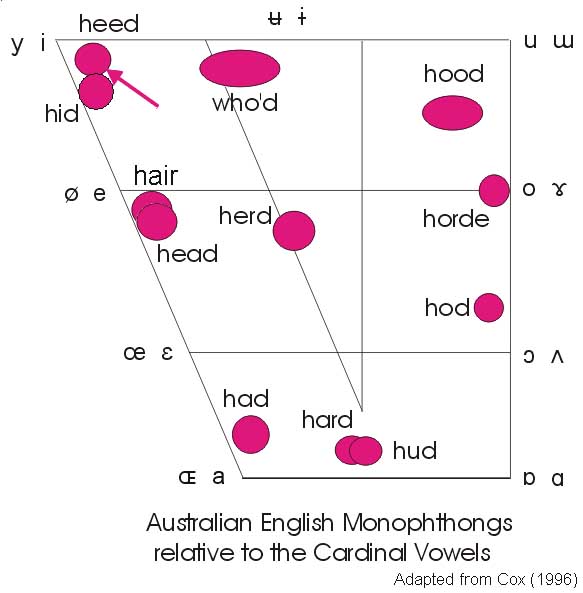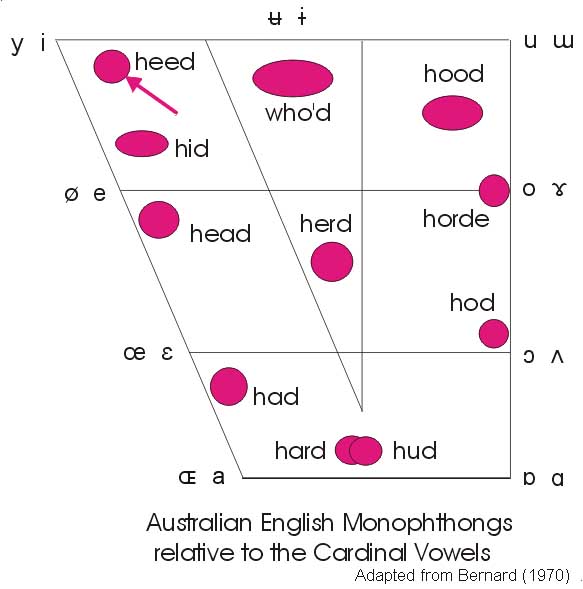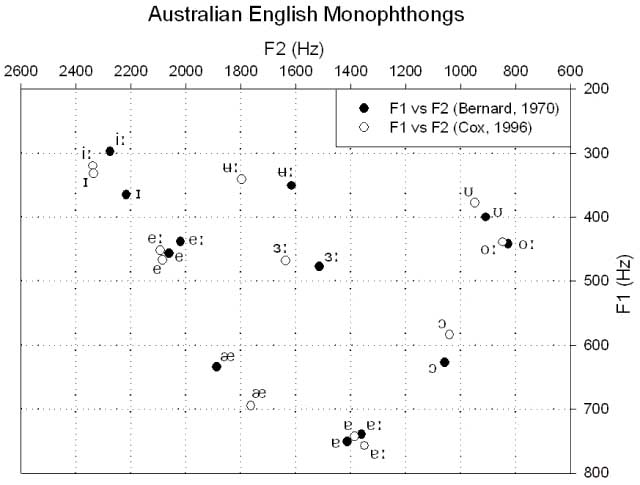Australian English monophthongs
Australian English Monophthongs
Robert Mannell and Felicity Cox

Figure 1: The monophthongs of Australian English. The vowels on this diagram are based on an acoustic analysis of Australian English vowels by Cox (1996). The acoustic data for her male subjects have been translated into an "auditory" representation for display on a cardinal vowel diagram. These vowel positions represent typical vowel productions by young Australian speakers from Sydney in the early 1990s and are more representative of current Australian speech patterns than is the pattern in figure 2.

Figure 2: The monophthongs of Australian English. The vowels on this diagram are based on an acoustic analysis of Australian English vowels by Bernard (1970). The acoustic data for his male speakers of General Australian English subjects have been translated into an "auditory" representation for display on a cardinal vowel diagram. These vowel positions represent typical vowel production by Australian speakers in the early 1960s and therefore represent the vowel patterns of some older Australians.
Comparison of these two vowel charts indicates a number of significant changes in Australian English over the 35 year period between these two studies (see Cox, 1999). /ɪ/ has moved upward towards the /iː/ vowel target. /æ/ has moved down. /ɔ/ has moved up. /ʉː/ has moved further forward and /ɜː/ has also moved forward.
The following diagram (figure 3) displays the original two sets of acoustic data together. In this diagram the two dimensions represent resonances (formants), or spectral peaks, in the vowel acoustic spectrum. The first formant (F1) correlates negatively with vowel height and the second formant (F2) correlates with vowel fronting.

Figure 3: The monophthongs of Australian English. This diagram summarises the results of the acoustic studies of Bernard (1970) and Cox (1996). This data is for male speakers only. It includes all of Cox's male subjects, but only Bernard's male General Australian speakers. Female speakers show a similar pattern. See also Cox (1999).
Bernard's data for /e:/ is included here for comparison, even though he still treated this vowel as a centring diphthong (/eə/) rather than a monophthong. It should be noted, however, that even in Bernard's data only about 20% of subjects produced a measurable second target for this vowel. This suggests that the change of /eː/ from a diphthong [eə] to a monophthong [eː] was already well under way in the 1960s.
Also see the topic on Distinctive Features: Australian English Vowels for a further discussion of Australian and American English vowels.
References
- Bernard, J., "Toward the acoustic specification of Australian English", Zeitschrift fur Phonetik, Sprachwissenschaft und Kommunikationsforschung, Band 23, Heft 2/3, 1970.
- Bernard, J. and Mannell, R., "A study of /h_d/ words in Australian English", Working Papers of the Speech, Hearing and Language Research Centre, Macquarie University, 1986.
- Cox, F., An acoustic study of vowel variation in Australian English, Unpublished doctoral dissertation, Macquarie University, 1996.
- Cox, F., "Vowel change in Australian English", Phonetica, 56, 1-27, 1999.
Content owner: Department of Linguistics Last updated: 12 Mar 2024 10:50am
